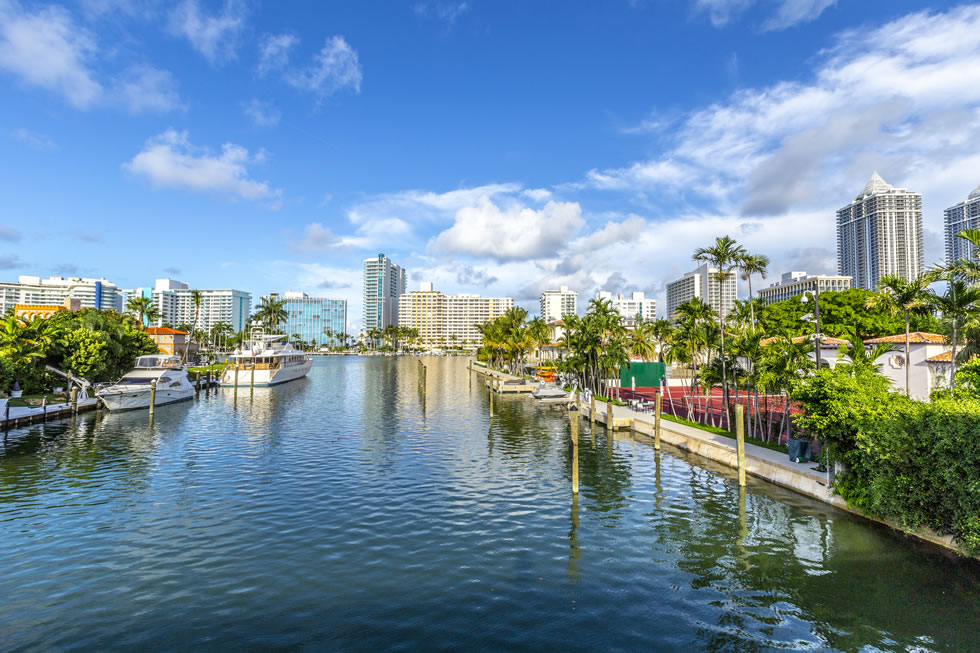
Almost everyone has at least a fleeting fantasy of living near the ocean, particularly in the midst of a pleasant vacation on a sparkling sunny day. A recent survey by Porch.com found that 45 percent of American respondents said their dream home would be a waterfront property and 52 percent of Europeans expressed that preference.
Waterfront homes, whether they’re on the ocean, a bay, a lake or a river, come with a high price tag. Recent research by Zillow, a real estate marketplace, found that the sales price premium for waterfront homes was 36 percent in 2017, meaning that a similar home in a location away from the water would be significantly less expensive. However, the Zillow researchers found that the premiums paid for waterfront have shrunk over time, down from 54 percent in 2012 and from the average premium of 41 percent for the past 22 years.
To research waterfront home prices in more detail, we connected with real estate affiliates at Coldwell Banker to provide local pricing reference points – from coast to coast.
East Coast:
"Non-waterfront properties in the Tampa Bay area sell for about 47 percent less than waterfront properties on the Gulf coast," says Kai Ozkul, an affiliated agent with Coldwell Banker Residential Real Estate in Tampa. "A home buyer for an average property can expect to pay around $770,000 for a waterfront home, compared to $350,000 for a comparable property that’s not on the water."
West Coast:
"The average price of a coastal, on-the-water home in La Jolla, which is the upscale area of San Diego, is $8 to $10 million, while homes in the inland, upscale area of Rancho Santa Fe average $4 to $6 million," says Pete Middleton, an agent affiliated with the La Jolla office of Coldwell Banker Residential Brokerage.
Waterfront homes are often cited as "recession-resistant" because they hold onto their value even during housing market downturns. The limited availability of waterfront lots adds to their desirability and, therefore, their cost.
Six extra expenses of waterfront homes
Living near water or on waterfront land adds multiple expenses that you wouldn’t have to pay for a similar home located farther from water. For many homeowners, the added expenses are well worth it for the glimpse of water and the emotional relaxation of watching changing tides, ripples and the play of light and liquid.
Some of the additional costs of waterfront property include:
- Flood insurance. The National Flood Insurance Program provides flood insurance for homeowners, a requirement for homes located within flood zones and optional for other homeowners. Flood insurance is not included in your regular homeowner’s insurance policy. While the average annual premium for homeowners is currently $866, the Insurance Journal says the recent 8 percent increase in premiums will bring the average to $935. However, the average includes all homeowners with flood insurance. Premiums for waterfront homes and those in high risk areas are significantly higher, as much as $2,500 or more per year.
- Higher homeowner’s insurance costs. Your homeowner’s insurance premiums are influenced by a variety of factors such as your home’s size, construction materials, age and location. Homes near water may carry higher costs if they’re in an area prone to high winds and hurricanes. You may also need to increase your coverage level to pay for short-term housing in case you need to evacuate after storm damage. Some homeowner’s insurance policies in storm-prone areas require higher deductibles as well as higher premiums.
- Higher maintenance costs. Those weathered clapboard beach houses can be charming but keeping them in good shape can cost you more money than a home located away from water. Humidity, mold and corrosion from salt can all do damage to your roof, your home’s exterior and your home’s interior.
- Storm prep and repair. As we’ve seen, devastation from hurricanes Michael, Florence, Matthew and Irma has destroyed and damaged homes. While insurance covers some of the repair costs, you’ll also face lost work time and the potential for temporary relocation. Even if a storm doesn’t hit, you’re likely to spend time and money preparing for the possibility with storm windows or plywood and moving lighter-weight items indoors. You may also want to buy a generator if your home is an area prone to power outages from hurricanes or Nor’easters.
- Coastal restoration. If you own a home on a beach, you may find yourself spending time and money on restoring property after a storm. In some locations, communities and private residents pitch in to restore dunes to protect homes from future storms.
- Building code challenges. If you’re building a new home or remodeling an existing home near the water, you may find yourself forced to spend extra money to build your house on a higher foundation or to install wind-resistant windows to meet local building requirements.
While waterfront property and homes near water have their appeal, it’s best to go into a purchase with full knowledge of the expenses you’ll bear as well as the pleasure you’ll get from a water view.
